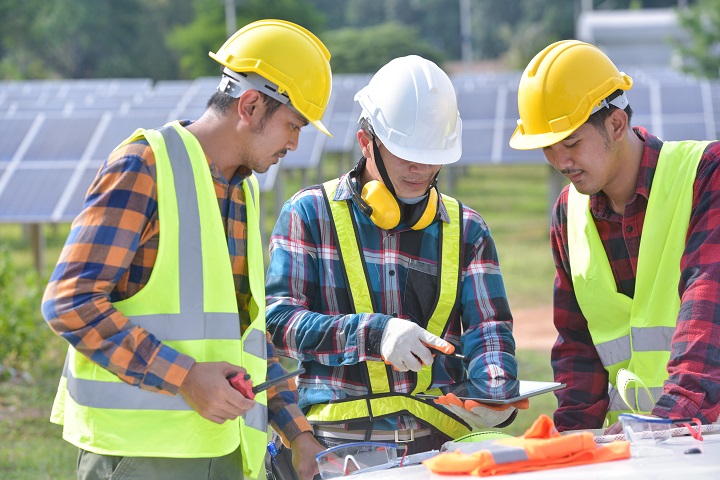
Group of engineers meeting on building roof solar. engineer and electrician checking and resolve problem of generate power in solar power plant.
For the majority of businesses, work isn’t entirely done in the office. Depending on the nature of the products and services you sell, it may be imperative for you to have a team out and about meeting your customers’ needs.
Whether you’re having a construction site led by field engineers or you do offer managed IT services (both of which require your employees to be out in the field), you need the right tools to ensure seamless workflow and improved productivity.
One of the tools that may benefit your business during field service is field service management software. You can use this tool to monitor the progress of your projects and collect data for all your field operations. It’s said that there’s much more this application can do for your business. Learn more about the software here.
This article will show you three technologies that you can leverage to streamline your field operations and help your company. Continue reading to learn more.
Cloud Technology Cloud-based software gives you a cost-effective way to manage data collected from field operations. It also serves as a medium for establishing real-time communication between technicians, managers, and customers. A cloud-hosted field service management system connects field workers, including service managers, with back-end and front-end touchpoints using one system for capturing, processing, and executing data collected from the field.
Additionally, you can use cloud-based software to enhance your customer experience by reducing waiting time. Channels that facilitate real-time communications give an avenue for responding to tasks quickly due to the speed offered by SaaS (Software as a Service) deployments.
One of the technologies that gives streamlined communication is the cloud-based Voice over Internet Protocol, or VoIP telephone system, which can be used for teleconferencing with your field workers. A cloud-based telephone system can be integrated with a smartphone using a mobile application. As a result, you can enjoy the flexibility of receiving calls anywhere using the free service.
Table of Contents
Internet of things (IoT) refers to the interconnectivity of smart devices through the Internet. Intelligent machines can monitor and interact with their environment and send the collected data back to the intended recipient.
For instance, you can network your field project site with cameras connected to a central access point online. With the current technology of cameras, you can monitor what is happening on your site using your smartphone in real-time. It’s said that you’ll only need to be granted access credentials by your networking professional to take advantage of the feature above.
Formerly, drone technology was primarily deployed in military operations. However, the application of drones has expanded to be used by SMEs (small and medium-sized enterprises), entrepreneurs, and large corporations to perform different tasks. Some of their applications are:
With a drone, you can capture high-resolution data and shoot photos in places difficult to reach, such as on mountaintops, coastlines, and islands. Moreover, you can use a drone to generate 3D or three-dimensional maps.
Farmers are believed to have incorporated drone technology into monitoring their crops. Drones fitted with infrared sensors are used to monitor crop health. The condition of the plants will help the farmer take the necessary steps to improve the health of their field. Apart from this, you can use drones to spray insecticides and apply fertilizer.
Currently, you can use a drone to capture motion pictures or photos, which was formally only possible with cranes and expensive helicopters. Additionally, flying drones are used in sports and real estate photography. Media houses are also using this technology to get footage and information from live field broadcasts.
You can use a drone to collect information and navigate rubble and debris, searching for injured victims after an artificial or natural disaster. Drones fitted with high-definition cameras, radars, and sensors can help rescue personnel gets a high field of view, eliminating the need to use human-crewed helicopters. Due to the flexibility of drones, you can use them to get a close-up view of hard-to-reach areas.
Poachers are a known threat to some of the globe’s endangered wild animals, such as elephants, big cats, and rhinos. The kind of drones used to aid in wildlife monitoring have sensors and thermal cameras that can work at night. As such, they can keep an eye on the environment at almost any time of the day. The videos and pictures captured help get insight into the behavior, habitat, and patterns of animals gravely affected by poaching.
Fieldwork is believed to be much easier and more effective when the relevant innovations are put in place. With technology, you can streamline workflow, improve productivity, cut losses, reduce time wastage, and perform tasks previously impossible to do through human means.
Depending on the type of field operations you’re involved in, there’s always a technology solution available for you to maximize. Do good research on the options you should use for your fieldwork to benefit from them after procurement successfully.
Starting your business journey means knowing your brand values. Then, share them everywhere. Companies that… Read More
Charting the future of remote work lies in finding the balance between autonomy and surveillance,… Read More
13377x Proxy: 13377x Original Site 1337x Official Site and Torrents Sites to Download free movies,… Read More
Proxy & Mirror Sites to Unblock LimeTorrents.cc. Top working LimeTorrents alternatives sites list. Movies, TV… Read More
Afdah Movies is a TV site on the internet. There are a lot of sites… Read More
Einthusan.tv is a popular website to watch TV shows and movies. Einthusan alternatives & competitors:… Read More